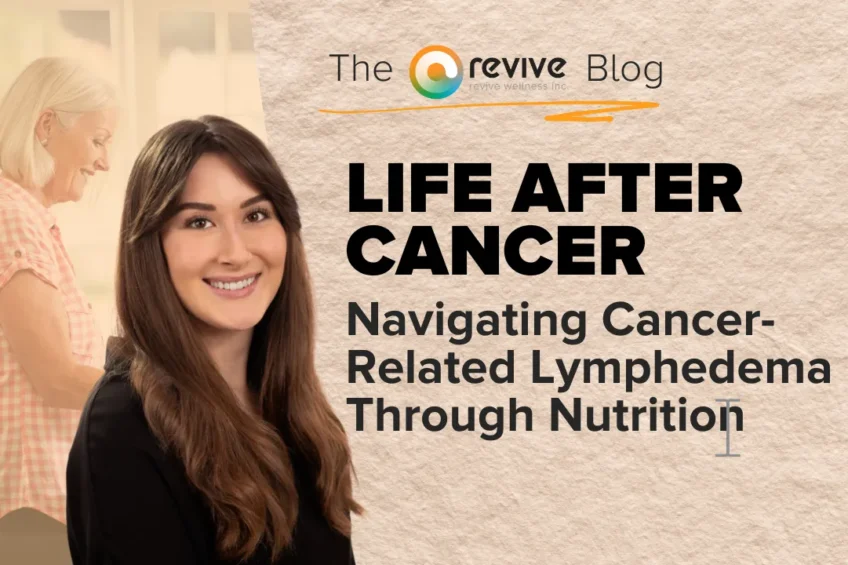Navigating Cancer-Related Lymphedema Through Nutrition
🎗️ The Journey Beyond Cancer Treatment
Finishing cancer treatment is a major milestone! While this phase brings relief and excitement, the post-treatment stage is one of healing—and it comes with unique challenges. Cancer treatments are designed to improve outcomes, but they may also affect nearby organs or tissues, leading to side effects that can appear months or even years later. One lesser-known late side effect is lymphedema.
🔬 What is Lymphedema?
Lymphedema is a condition where swelling occurs due to a buildup of lymph in the soft tissues of a limb. Lymph is a protein-rich fluid that is part of the lymphatic system.
🔍 The Role of the Lymphatic System
Your lymphatic system plays a critical role in (1):
- ✅ Protecting against infections (removing germs & toxins)
- ✅ Draining extra fluid from tissues back into the bloodstream
- ✅ Removing waste like damaged or abnormal cells
- ✅ Transporting fats & vitamins from your digestive system to other parts of the body.
📊 Lymphedema in Cancer Survivors
Lymphedema is common in individuals who have undergone cancer treatments involving:
- Lymph node removal (surgery)
- Radiation therapy (damaging lymph nodes)
👉 Higher Risk: The more lymph nodes affected, the greater the likelihood of developing lymphedema (2). People with breast cancer have a higher risk of lymphedema because they have a lot of lymph nodes under the arm that may be removed during surgery or affected by radiation.
Although not widely discussed, it is estimated that 155,000 Canadian cancer survivors were affected by lymphedema in 2017 (3-4).
🚦 Stages of Lymphedema: What to Expect
Like cancer, lymphedema progresses through different stages (5):
- Stage 0 🔵: No visible swelling, but feelings of tightness, heaviness, or tingling in a limb.
- Stage 1 🟢: Swelling may come and go. If you press your finger into the skin, the indent stays for a few seconds. Elevation helps.
- Stage 2 🟡: Swelling does not go away with elevation. The affected area may feel harder, more painful, or difficult to move.
- Stage 3 🔴: The most severe stage
- Major swelling limits movement
- Swelling causes pain and pressure
- Skin becomes more prone to infections
- Body image and confidence may be impacted (6).
🍽️ Nutrition & Lymphedema: 5 Key Considerations
While compression therapy, movement, and exercise are often used to manage lymphedema, nutrition plays a crucial role too (3,7)!
1️⃣ 🧂 Control Sodium Intake
- Why? Excess sodium or salt causes the body to hold onto more fluid, worsening swelling (7).
- Tip: Choose naturally low-sodium foods:
- Fresh vegetables & fruits 🍎🥦
- Lean meats 🍗
- Yogurt & milk 🥛
- Whole grains (quinoa, brown rice, barley) 🌾
2️⃣ 💧 Stay Hydrated
- Why? Unlike other types of swelling, reducing fluids is NOT recommended for lymphedema. If you’re dehydrated, your body holds onto more fluid, worsening swelling (7).
- Tip: To stay hydrated, choose fluids like:
- Water 💦 (all varieties)
- Milk or plant-based alternatives 🥛
- Herbal tea 🍵
- Decaffeinated coffee ☕
3️⃣ 🍗 Eat Enough Protein
- Why? Protein supports wound healing & muscle maintenance (8).
- Risk: Excess fluid from lymphedema can help bacteria grow, which increases the risk of infection if wounds develop (9).
- Tip: Incorporate lean proteins like:
- Chicken 🍗
- Fish 🐟
- Tofu & beans 🫘
4️⃣ 🌾 Prioritize Fibre
- Why? Incorporating enough fibre in our diet can prevent or reduce chronic inflammation from inflammatory conditions, like lymphedema, obesity, high blood cholesterol, and more (7).
- Tip: Aim for 30g of fibre per day (10).
- Food Sources:
- Whole grains 🌾
- Fruits & vegetables 🥕🍓
- Nuts, seeds, beans, lentils 🥜 🫘
5️⃣ 🥑 Consider Fat Intake
- Why? The lymphatic system absorbs fat from food. A high-fat diet may stress this system, worsening lymphedema (7).
- Tip: A lower fat diet is not needed for everyone with lymphedema, but may be helpful in certain cases.
- Food Sources:
- Cooking oils (canola, olive, avocado, etc.) 🫒
- Avocado 🥑
- Nuts and seeds 🥜
- Milk and cheese 🥛 🧀
- Eggs 🥚
- Meat, poultry, and fish 🍗 🐟
💪 Empowering Your Recovery
Managing lymphedema requires a holistic approach—including mental health support, nutrition, and movement.
At Revive Wellness, we are committed to providing personalized support to help you take control of your health.
📞 Book a free discovery call with our cancer dietitian, Laura, to learn how nutrition can help you thrive! 🌱💛
Continue reading:
👉 Cancer and recovery nutrition coaching
👉 Sweet Relief: Why You Shouldn’t Take the Phrase “Sugar Feeds Cancer” Too Seriously
About the Author

Laura Velcoff
I am all about helping people find joy in food again. Whether you are experiencing side effects of cancer, struggling with gut symptoms, or just wanting to relearn how to enjoy your meals, I’ve got your back. Together, we can make a positive impact by using strategies that are not only backed by evidence, but also guide you towards lasting behaviour change. Change can be so tough, but incredibly empowering when taking control of your own health. I am very excited to work alongside you in supporting your mind, body, and overall well-being!
References
- The lymphatic system. (n.d.). Lymphoma Action. https://lymphoma-action.org.uk/sites/default/files/media/documents/2021-02/LYMweb0103WhatIsLymphaticSys2021v3.pdf
- Lymphedema. (n.d.). Canadian Cancer Society. https://cancer.ca/en/treatments/side-effects/lymphedema
- Shaitelman, S. F., Cromwell, K. D., Rasmussen, J. C., Stout, N. L., Armer, J. M., Lasinski, B. B., & Cormier, J. N. (2014). Recent progress in the treatment and prevention of cancer‐related lymphedema. CA: A Cancer Journal for Clinicians, 65(1), 55–81. https://doi.org/10.3322/caac.21253
- Keast, D., & Towers, A. (2017). The rising prevalence of lymphedema in Canada: A continuing dialogue. Pathways, 1-8. https://canadalymph.ca/wp-content/uploads/2015/04/PATHWAYS-Spring-2017-The-rising-prevalence-of-lymphedema-in-Canada.pdf
- Stages of lymphedema. (n.d.). National Lymphedema Network. https://lymphnet.org/stages-of-lymphedema
- Fu, M. R., Ridner, S. H., Hu, S., Stewart, B. R., Cormier, J. N., & Armer, J. M. (2012). Psychosocial impact of lymphedema: a systematic review of literature from 2004 to 2011. Psycho-oncology, 22(7), 1466–1484. https://doi.org/10.1002/pon.3201
- Cavezzi, A., Urso, S. U., Ambrosini, L., Croci, S., Campana, F., Mosti, G. (2012). Lymphedema and nutrition: a review. Veins and Lymphatics, 8(8220), 24-29. https://www.pagepressjournals.org/index.php/vl/article/view/8220/8102
- Posthauer, M., Banks, M., Dorner, B., Schols, J. (2015). The Role of Nutrition for Pressure Ulcer Management: National Pressure Ulcer Advisory Panel, European Pressure Ulcer Advisory Panel, and Pan Pacific Pressure Injury Alliance White Paper. Advances in Skin & Wound Care, 28(4)1, 75-188. https://journals.lww.com/aswcjournal/fulltext/2015/04000/the_role_of_nutrition_for_pressure_ulcer.7.aspx
- Vignes, S., Poizeau, F., Dupuy, A. (2022). Cellulitis risk factors for patients with primary or secondary lymphedema. Journal of Vascular Surgery: Venous and Lymphatic Disorders, 10(1), 179-185. ⟨10.1016/j.jvsv.2021.04.009⟩. ⟨hal-03248201⟩
- World Cancer Research Fund International. (2025, January 28). Eat a diet rich in wholegrains, vegetables, fruit and beans: Recommendation evidence. https://www.wcrf.org/research-policy/evidence-for-our-recommendations/wholegrains-veg-fruit-beans/

